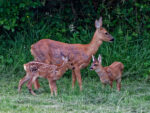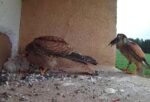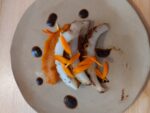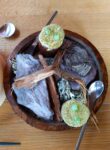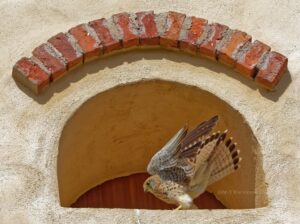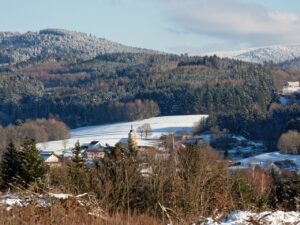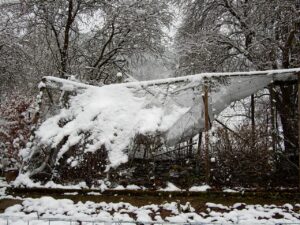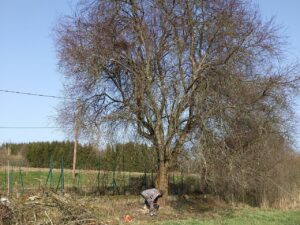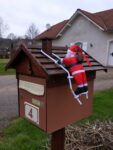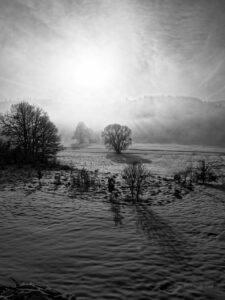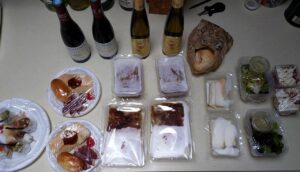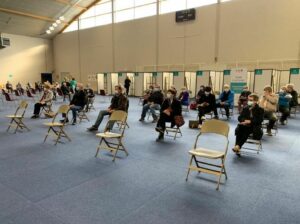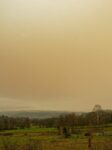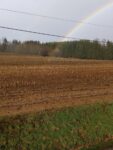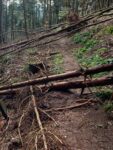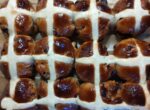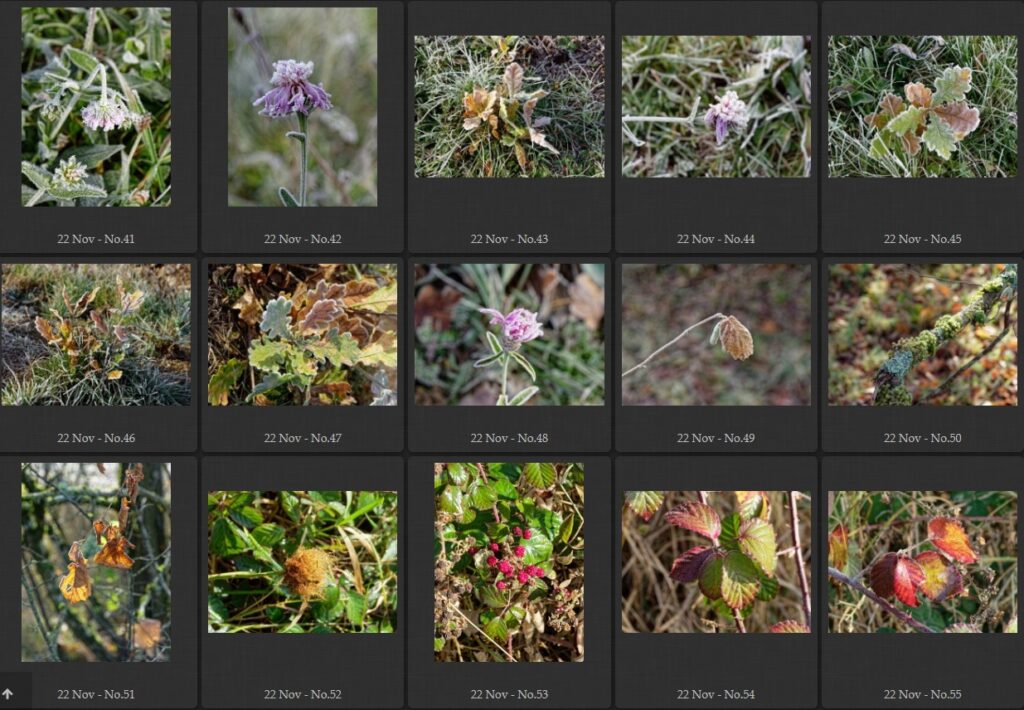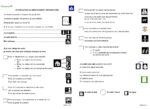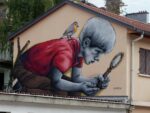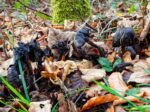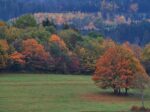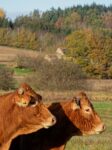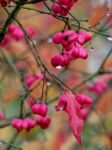To download a printable PDF version (no pictures)
click on this link E2E2021no4.pdf (six A4 pages)
Some photographs have links to more images and
there are also links to photographs in the text
This morning the snow was still lying on the fields outside, the postman delivered our first Christmas card, and aromas issued from the kitchen as John baked the alcohol-soaked fruit Christmas cake. So it seemed a good time to look back over the last three months, before Christmas activities take over.
As Covid travel restrictions start to be re-imposed, we are so thankful that we had the luxury of spending two months catching up with family and friends in the UK after eighteen months absence. At one stage of the confinement we had joked that we would have forgotten how to talk to other people, and it was a great pleasure to indulge once more.
We set out for Calais at 7.20 (early nowadays for us) on 8th September, clutching our negative pre-departure Covid test results, double vaccination certificates (passes sanitaires), and photocopies of the forms we’d been required to fill in. It was a hot day, and good to stop for coffees and refreshments. We were really struck by the contrast between the French service stations (with scrupulous hygiene, the need to show passes sanitaires before purchasing coffee and obligatory mask wearing) and the casual, mask-less and grubbier Dover one. Although the French roads had been busy with work traffic and lorries for the early part of the journey, the motorway between Reims and Calais was quieter than usual, with few UK cars. The coned-off approach to the tunnel check-in felt like a maze, but there were short queues when we made it, and we were able to board an earlier Eurotunnel train. We rarely take the tunnel but this time, as prices did not differ greatly from ferry fares, it seemed preferable to remain in our car rather than mingle in lounges and it took less time. So we reached our front door in Letchworth around 17.20. After clearing the dead leaves piled up against the front door, it was good to find the house surprisingly clean inside, apart from dead spiders and flies, and the fridge and freezer recovered and usable, thanks to Toby’s clearing up after it defrosted when the power cut off. It was good to see Toby and Farrah who came round to greet us a bit later. Toby had started a new job, Farrah had progressed from Year 7 to year 9 at school since we last saw them, and Toby was able to tell us about his visit to the secondary school in Melton Mowbray that Jacob will be going to next year, so big changes.
During our stay we heard more about Toby’s contract with a consultancy and current work for Pret a Manger. But he was very busy and also solicitous for our health, so protected us from the autumn coughs and colds that Jacob and Farrah inevitably brought home from school. Leila also planned to come and stay for several days while she was still on sick-leave with long Covid, but gave us a few days first to start sorting out the house and garden.
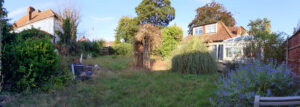
garden jungle (link)
The garden, unattended for eighteen months, was the most urgent to tackle, while the weather was good, as the grass and weeds were rampant, the hedges and ivy unruly, and there were dead trees and shrubs to cut down and dispose of. The gardening firms John initially contacted on-line or by phone were fully booked until the end of October, even for an estimate. Helen accosted Bob the Gardener who was trimming a hedge further down the road, and he seemed keen, noted down all the details, said he and an older colleague could do it in a one or one-and-a-half days, and he would get back to us with confirmation of price and a date. He didn’t. Did he feel overwhelmed by the jungle? So when Dan, a contact through an internet trader website, visited to assess and offered us two men for half a day the following week, with more hours later, we accepted.
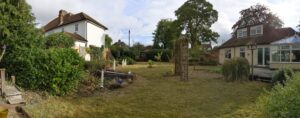
tamed garden (link)
And wow, didn’t Dan and James work hard! They had finished their morning job earlier than expected, so worked on our garden from 10.30 – 19.00, with frequent trips to the tip with branches from the hedges, shrub trimmings and dead trees. By the end of the day, we could see the end of the garden, the pavements outside were clear of our overhanging greenery and the house was considerable lighter after the removal of dead trees. The only minor disaster was the cutting through of an outside socket power cable, but Dan arranged for a mate to repair it a few days later. He departed, promising to invoice us from Majorca, where he was flying next day (and where we hope our prompt payment contributed to his holiday pleasures).
Leila was able to witness, from our sofa, this taming of the jungle. She was still getting very tired, and although we were able to do quite a few things during her visit, she still need to sit down and rest quite a bit. The first day, she was also nursing a wasp sting and we contented ourselves with quietly opening birthday and Christmas presents from last year! However, Helen appreciated her advice on a shopping trip to M&S, and we all went to the Collectors’ Market in Hitchin. Helen and Leila also picked up Jacob on the Friday, when he was still very chatty about his Year 6 activities, especially sports, at school that day. We also had fun trying out a French Asterix Monopoly game and finally playing the adult rules of the Train Game. (When Jacob was quite young he had loved seeing the trains criss-crossing the map of Europe on the board, and was desperate to join in, so we had invented some simpler rules).
The first two weeks of our stay had passed rapidly, and as well as the garden, John had tackled some house problems, replacing a leaking rotted rubber downstairs loo pan seal, planing down the bathroom door and replacing the handle, installing a Raspberry Pi power cut detector, and we also considered re-decorating the upstairs bedroom, but it got no further than discussion. Helen had been over-enthusiastic about cleaning and had broken the plastic mop bucket (but it had been outside in the sun all the time), so replaced it with a more durable metal one. On the health front, we had duly posted our required Covid PCR test in a mail box outside the Jordans Cereal building in Biggleswade within 48 hours of our arrival, and Helen had arranged eye, foot and hair appointments (though perhaps a hair appointment at “Dead Swanky” does not count as a health appointment). It was a first professional cut since the start of Covid and acting-hairdresser John clearly felt demoted. We later also booked an annual car-service and brake disc pad replacements for Snowy (despite the Toyota dealer’s receptionist insisting over the phone that our model had drum rear brakes).
With all that done, we were able to continue to tackle the garden renovation at leisure, weeding, doing further pruning and replacing dead plants. A local garden centre had reduced pots of clematis, honeysuckle, Russian vine and spirea, we’d brought over some wisteria grown from seeds, and Ann and Derek later gave us some pheasant berry plants and hellebore. We regretfully gave up on the invasive Russian vine, but hope the rest of the plants now feel at home and survive. We were also able to arrange for a Letchworth gardening firm to come in once a month for future regular maintenance. We could now turn our thoughts to catching up with friends.
This was not as straightforward as it sounds. Helen had been sorry to miss the wedding anniversary of Barbara and Paul so close to our arrival. Alistair e-mailed that Susan had been rushed to hospital a few days before their planned visit. The fuel-buying panic meant that Graham and Julia were unable to find any petrol or diesel in the Maidenhead area. But we were delighted to welcome Dilys, who’d discovered she could make it up from Eastbourne with only one change of trains and without having to cross between London terminals.
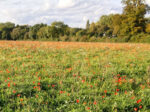
Radwell Meadows poppy field
When Jessica stayed for a few days we enjoyed a couple of local walks, one of which included an unexpected colourful field of poppies while the other offered rolling views, wild hops and lavender fields.
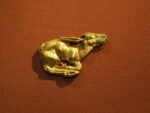
Saka gold deer plaque, Fitzwilliam Museum, Cambridge (link)
We also drove with her to the Fitzwilliam Museum in Cambridge to see the Gold of the Steppes exhibition.
As fuel problems eased, it was good to see Graham and Julia. Helen was also able to drive down to her cousin Kate’s funeral in north London. As their health problems had eased, we were glad that Barbara and Bruce came up from Winchester and Val could join us, and later Susan and Alistair were able to stop on their way to London at the start of November. Although we had all been living quiet lives, some coping with illness, and had few exciting events to recount, it was such a pleasure to meet up, share meals and chat with old friends.
We always enjoy spending time with John’s sister Ann and her husband Derek, so felt spoilt to see them not just once, but three times. We drove down to Tenterden to stay with them at the beginning of October and to finally take them out out to lunch, as promised, to celebrate their birthdays two months earlier. They chose The Pig at Bridge Place Hotel outside Canterbury, which, it turned out, had at one stage been the Bridge Country Club and had hosted legends like Led Zeppelin, the Moody Blues, the Kinks, the Yardbirds, the Barron Knights, Manfred Mann, Acker Bilk and Kenny Ball. Copies of old posters in the loos were the only reminders of the glory days, the food was average and the room crowded and noisy.

on Dymchurch sea wall
The following day we had a bracing walk in the sunshine and wind along the promenade at Dymchurch, avoiding the waves at high tide which crashed against and sprayed over promenade, then visited Sue, one of Helen’s first flat-mates in London in the sixties. Lunch was a pasta, a reminder of her many years spent in Reggio Calabria, and childhood memories of plum (from her garden) crumble.
John celebrated his birthday at the end of October with lunch (rather disappointing, works canteen-like) at Fergus Henderson’s starred St John restaurant in London with Helen and Jessica. Then Leila came to stay again, along with Ann and Derek. We were pleased to see that Leila seemed better than during her earlier stay. Friday mornings with us are incomplete for Leila without a trip to Hitchin and its Collectors’ Market, which Ann and Derek enjoyed too; but Leila rested next day while the rest of us walked across the fields to Ickleford village, where we paused for drinks in the timbered Old George before the return walk. On Sunday it felt as if we were making up for all the birthday and Christmas family celebrations we’d missed as Toby, Rachel, Farrah and Holly joined us and the nine of us we sat down to the splendid Sunday lunch that John and Ann had prepared, which was followed by either watching football or playing games. It was a shame that Jacob was not there to complete the party, but he had been at Toby’s the previous week during his half term and we had enjoyed spending time with him then.

evening view of the Thames
Making up for the very quiet birthday celebrations of 2020, we booked dinner a couple of days later at the recently opened Ekstedt at the Yard restaurant. We took the train down as far as Blackfriars Station, which was much transformed since our London days from a soot-encrusted hulk to glass palace, with the train stopping part way across the Thames, giving splendid evening views of the illuminated buildings up and down the curving river. The walk along the Embankment brought back memories of our riverside explorations together after work back in the dim and distant past. We met up with Jessica in the lobby of the Great Scotland Yard Hotel and were ushered to a table in the dimly lit restaurant close to the noisy kitchen and open fire to await a series of Scandinavian style taster dishes. Courses like the seared smoked venison heart, allspice, lingon berries, parsley, mushrooms and shallots which were heated in butter at the table and served with flatbread, were tasty, but we found the serving of only two small cep souffles along with three pine needle ice cream/wild blueberries at the end to share between three of us very niggardly (especially sharing food in these Covid times; later correspondence has resulted in a return invitation).
Three days later, we were all packed up and setting out to stay overnight with Ann and Derek, before an early morning start for the Eurotunnel and drive back to Entre-deux-Eaux. It had been so good to see family and so many of our friends again.
Back here, it felt like a mirror image of things that had needed to be sorted out in the UK – garden, health and house. After harvesting squash, marrows, parsley and a few surviving autumn raspberries from the potager which had been neglected for two months, it was time to put pots and tubs of delicate plants like geraniums, fuchsia and hydrangeas to overwinter in the third barn, to wrap protection around the peonies, clematis and roses outside, and to bring in trickle watering pipes and garden furniture before the frosts and snow. There were leeks, carrots, beetroot and parsnip to dig up when required and some curly kale.
We also needed to catch up with health appointments, starting with our Covid booster and flu jabs. We had collected our flu vaccines from the pharmacy, who said the Covid centre could do both at the same time, and the receptionists and doctor at the centre said the same. However, the nurses at the centre didn’t want to give the two at once, but wouldn’t say why, just “I don’t agree with it”, while insisting that they were only there to do Covid (one suspected the problem was lack of payment for extra work rather than health concerns), and that they didn’t have enough staff to give both to everyone (as we watched the three nurses standing chatting with no patients during our 15 minute “recovery” period).
That evening the French Prime Minister announced that over 65s would have their passe sanitaire cancelled on 15th December if they were eligible for a booster dose six months after their second injection but had not had it. This would mean they would not be able to go to restaurants, bars, cultural events etc. without an additional test. Booking slots for booster injections, many of which had been free when we booked, immediately filled up and are currently still hard to obtain, especially since the age group has been extended.

overturned flower pots (link)
Thank goodness we had got some of the flower tubs into the barn. On 11th November, as church bells tolled for Armistice Day, we opened the front door to find that six of the remaining plant tubs had been overturned during the night, with soil, plants and plastic fragments scattered across the tarmac strip between the house and road. What was upsetting was that no one had stopped to apologise or left a note during that day or the next so we reported it to the mairie, who said there had been no similar vandalism reports and suggested we contacted the gendarmerie in Fraize. After filling in the appropriate form online, we were summoned to Fraize where a trainee gendarme laboriously filled in another form with the same information. Not a good advert for the local policing, especially as they then said that they couldn’t do anything if we didn’t know the perpetrator(s)!
Six days after the event, Helen was clearing up all the earth, retrieving and replanting the tubs’ contents in remaining pots, and gathering up the shattered fragments of plastic, when the farmer, who had been roaring past all morning in his tractor with spraying tank attached, stopped and said rather sheepishly that it was he who had caused the damage, and offered to pay. (Had our mayor warned him that we had filed papers with the gendarmes?) As the pots were quite old, and village trade tends to be in goods rather than cash, Helen asked if he could let us have some manure for the vegetable plot instead. (Coincidentally, our neighbour in Letchworth had kindly given us some flower tubs that he no longer needed, though unfortunately they are still in Letchworth.)
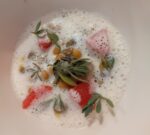
Mediterranean shellfish, chickpeas, tomato, purslane and shellfish foam
We then concentrated on other medical appointments (audiology and cardiology), house needs like replenishing the heating oil, and pleasures like pensioners’ games and a restorative lunch at the l’Imprimerie. It was on the morning of the oil delivery, twelve days after the flower tub incident that John opened the door so that the approaching oil delivery lorry could uncoil its hosepipe and fill up our tank inside the barn. In front of the door was more earth and plants and an overturned tub. But worse was to be seen. The door of the adjacent garage had been bashed in and was hanging off its frame. So, after the oil delivery, it was phone calls to our insurers and the gendarmerie. A few hours later two gendarmes came out to inspect the damage and quiz a passing neighbour whether they’d seen anything or had another explanation. Then we had to go into the gendarmerie in the afternoon to lodge a formal complaint. Fortunately it was not the trainee who was doing the form-filling, but, after a long wait, one of the men who’d been out to look at the damage. A colleague of his rang the farmer who said he was not responsible this time. So we are left with a nasty feeling of persecution, a promise from the gendarmes to keep their eyes open, and the need to organise estimates for replacing the door.
The fortnightly Scrabble group that Helen has been going to for many years, has finally folded, but has now been replaced by a choice of games, like Rummikub, Triominos, cards and also “normal” Scrabble, which has proved more popular. On alternate weeks the Brain Teasers group continues.
So there were exercises to prepare and refreshments to provide when it was Helen’s turn to run the session a couple of weeks ago. It’s always a bit of a struggle, but hopefully the mince spices and chocolate spice biscuits at the end helped. It was dark coming back from this week’s games session, so Helen saw all the Christmas lights, starting with the all-blue Christmas tree lights in Sainte Marguerite, and finishing with a surprise on our road. The Laines’ daughter has inherited their old house and it looks as if she is out to win this year’s village competition for the best display. It is not restrained or colour-themed.
And, to finish on this festive note, this Sunday lunch time Saint Nicolas will visit the children of Entre-deux-Eaux at the village hall, while Saulcy and Sainte Marguerite hold their Christmas markets with their mix of tasteful and lumpy crafts, mulled wine and home-made cakes.
After a month back in Entre-deux-Eaux, we are now watching the evolving requirements and restrictions for coming over to the UK for Christmas (and returning in the New Year!) and will put details of our plans in the covering e-mail. Meanwhile, enjoy your Christmas preparations!
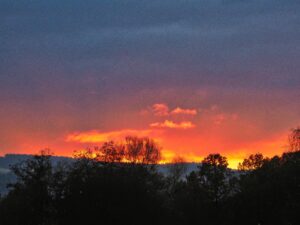
a November sunset before the snow











